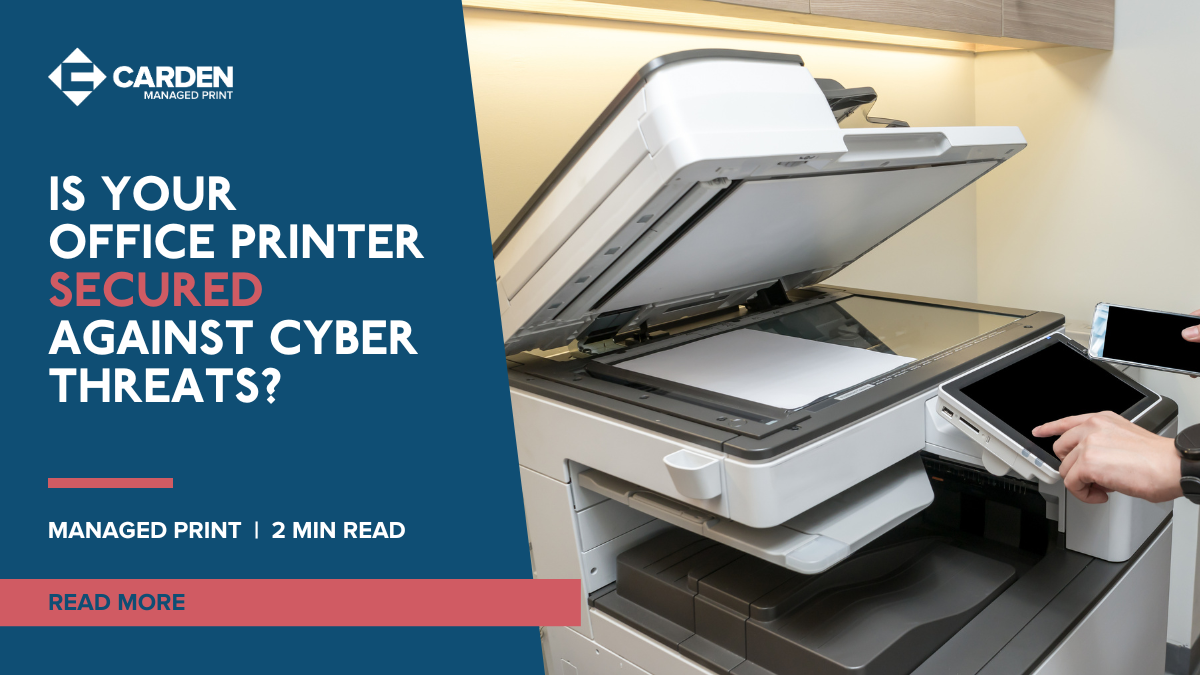When we think about cybersecurity in the workplace, printers don’t usually come to mind. But today’s printers are a far cry from the simple machines of the past. They’re now smart, network-connected devices—complete with internal storage, internet access, and cloud integration.
That means your office printer could be a hidden security risk. If left unmanaged, it might be the weakest link in your IT setup.
Let’s explore the risks—and how Carden Managed Print can help protect your business with a secure print service.
🔓 1. Printers Are Connected—and That Means Vulnerable
Most modern printers are connected to your company network. Some have Wi-Fi, email capabilities, and even access to cloud platforms like OneDrive or Google Drive.
While these features are great for productivity, they also create potential entry points for cybercriminals. Unsecured printers can be hacked and used to access the wider network, steal data, or spread malware.
And if printer firmware isn’t updated regularly, known vulnerabilities can remain unpatched—making it easier for hackers to gain access.
📄 2. Sensitive Documents Left Unattended
A common day-to-day risk is printed documents left sitting in the output tray. Whether it’s payslips, contracts, or customer records—anyone walking past the printer could pick them up, either by mistake or deliberately.
In shared offices or regulated industries, this can lead to serious data breaches and potential GDPR violations.
🧠 3. Internal Threats and Misuse
Not all security risks come from outside. Sometimes, the danger is internal. Without print monitoring in place, staff can misuse printers without accountability—intentionally or not.
Examples include:
- Printing confidential materials and leaving them unsecured
- Sending documents to the wrong printer
- Using printers for personal or unauthorised jobs
Without proper controls, it’s difficult to track who printed what, when, and why.
🗂️ 4. Printers Often Store Data
Many printers store digital copies of scanned or printed documents on internal hard drives or memory. This data can remain on the device long after a job is completed.
If your business disposes of or sells an old printer without properly wiping its memory, that stored information could be accessed by unauthorised parties. That’s a major risk, especially for businesses handling sensitive or regulated data.
🔐 5. How Managed Print Services Help
Managed Print Services don’t just simplify your printing—they also make it far more secure.
With Carden Managed Print, your printer setup is designed and maintained with security in mind. Here’s how we help protect your data:
- Secure Print Release
Documents are only printed when the authorised user is physically at the printer and authenticates (via PIN, card swipe, or secure login). - User Access Controls
Control who can print, copy, or scan—perfect for limiting access to sensitive features or departments. - Monitoring and Audit Trails
Keep a clear record of who printed what and when. This improves accountability and makes it easier to investigate potential issues. - Automatic Firmware Updates
We regularly update printer firmware to patch vulnerabilities and ensure devices are protected against the latest threats. - Hard Drive Encryption and Wiping
Devices are encrypted, and drives are securely wiped before being replaced or decommissioned.
Is Your Printer a Security Risk?
Printers are often overlooked, but they’re an important part of your IT security. If you haven’t assessed the risks or don’t have safeguards in place, it may be time to re-evaluate your setup.
At Carden Managed Print, we don’t just keep your devices running—we keep your data protected.
Worried about print security?
Contact us today for a free print security audit and see how we can help protect your business from hidden threats.

